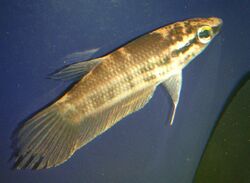Biology:Penang betta
| Penang betta | |
|---|---|

| |
| Scientific classification | |
| Domain: | Eukaryota |
| Kingdom: | Animalia |
| Phylum: | Chordata |
| Class: | Actinopterygii |
| Order: | Anabantiformes |
| Family: | Osphronemidae |
| Genus: | Betta |
| Species: | B. pugnax
|
| Binomial name | |
| Betta pugnax (Cantor, 1849)
| |
| Synonyms[2] | |
| |
The Penang betta (Betta pugnax) is a species of gourami native to Southeast Asia and common in swiftly flowing forest streams of the Malay Peninsula, Thailand, Sumatra, and the Riau Islands. In addition to its native range, the species has been introduced to Guam. It can be found amongst the vegetation growing along the banks. This species can reach a length of 6.7 centimetres (2.6 in) SL.[2] It is one of the mouthbrooding Betta species. This species, as a natural predator of mosquito larvae, has found use in mosquito control efforts.[3] Prior to its being eclipsed in Western public recognition by the mass-imported B. splendens (the Siamese fighting fish), B. pugnax was well known as a fighting fish, as denoted by the specific epithet of pugnax, attracting the interest of scientists studying animal behaviour at least as long ago as the 1880s.[4]
References
- ↑ Low B.W. (2019). "Betta pugnax.". IUCN Red List of Threatened Species 2019: e.T89808916A89808924. doi:10.2305/IUCN.UK.2019-2.RLTS.T89808916A89808924.en. https://www.iucnredlist.org/species/89808916/89808924.
- ↑ 2.0 2.1 Froese, Rainer and Pauly, Daniel, eds. (2014). "Betta pugnax" in FishBase. February 2014 version.
- ↑ Gerberich, John B. (1946). "An Annotated Bibliography of Papers Relating to the Control of Mosquitoes by the Use of Fish". American Midland Naturalist (The University of Notre Dame) 36 (1): 87‒131. doi:10.2307/2421623.
- ↑ Allen, Grant (1881). "Sight and Smell in Vertebrates". Mind 6 (24): 453‒71. doi:10.1093/mind/os-VI.24.453.
External links
Wikidata ☰ Q1091266 entry
ms:Ikan Sempilai
 |


